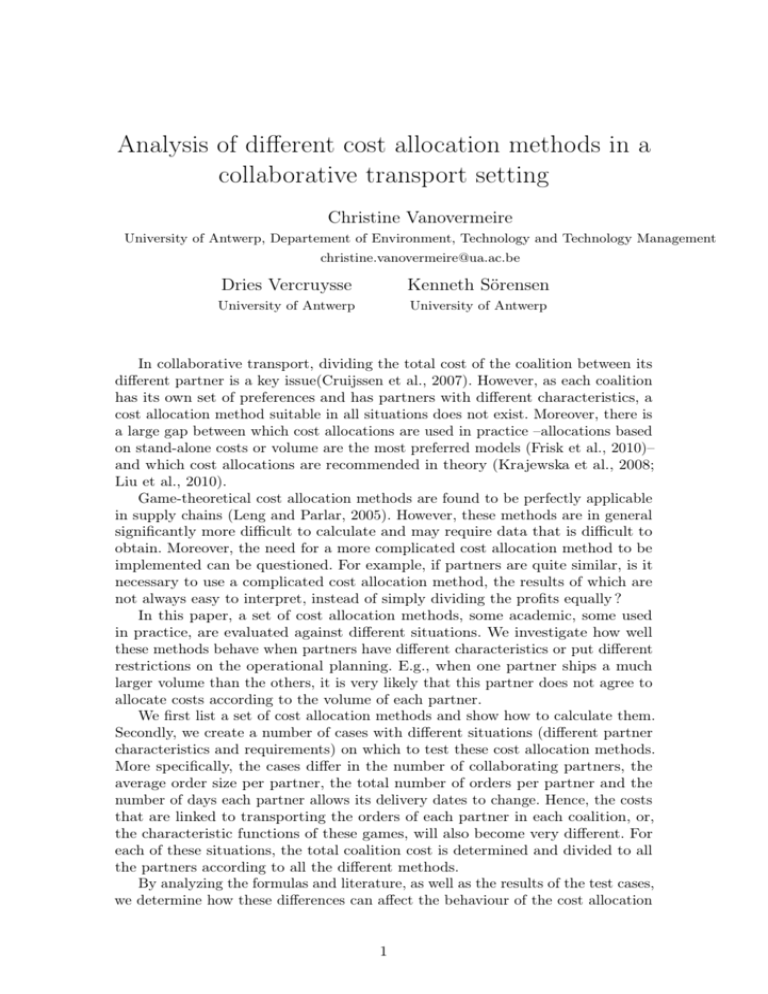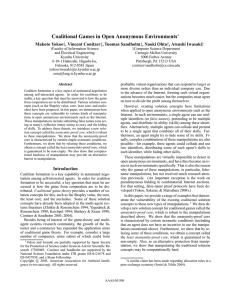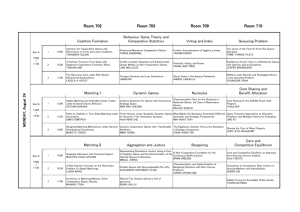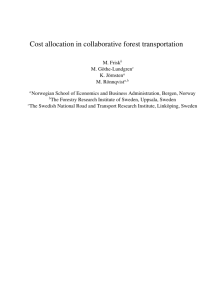Analysis of different cost allocation methods in a
advertisement

Analysis of different cost allocation methods in a collaborative transport setting Christine Vanovermeire University of Antwerp, Departement of Environment, Technology and Technology Management christine.vanovermeire@ua.ac.be Dries Vercruysse Kenneth Sörensen University of Antwerp University of Antwerp In collaborative transport, dividing the total cost of the coalition between its different partner is a key issue(Cruijssen et al., 2007). However, as each coalition has its own set of preferences and has partners with different characteristics, a cost allocation method suitable in all situations does not exist. Moreover, there is a large gap between which cost allocations are used in practice –allocations based on stand-alone costs or volume are the most preferred models (Frisk et al., 2010)– and which cost allocations are recommended in theory (Krajewska et al., 2008; Liu et al., 2010). Game-theoretical cost allocation methods are found to be perfectly applicable in supply chains (Leng and Parlar, 2005). However, these methods are in general significantly more difficult to calculate and may require data that is difficult to obtain. Moreover, the need for a more complicated cost allocation method to be implemented can be questioned. For example, if partners are quite similar, is it necessary to use a complicated cost allocation method, the results of which are not always easy to interpret, instead of simply dividing the profits equally ? In this paper, a set of cost allocation methods, some academic, some used in practice, are evaluated against different situations. We investigate how well these methods behave when partners have different characteristics or put different restrictions on the operational planning. E.g., when one partner ships a much larger volume than the others, it is very likely that this partner does not agree to allocate costs according to the volume of each partner. We first list a set of cost allocation methods and show how to calculate them. Secondly, we create a number of cases with different situations (different partner characteristics and requirements) on which to test these cost allocation methods. More specifically, the cases differ in the number of collaborating partners, the average order size per partner, the total number of orders per partner and the number of days each partner allows its delivery dates to change. Hence, the costs that are linked to transporting the orders of each partner in each coalition, or, the characteristic functions of these games, will also become very different. For each of these situations, the total coalition cost is determined and divided to all the partners according to all the different methods. By analyzing the formulas and literature, as well as the results of the test cases, we determine how these differences can affect the behaviour of the cost allocation 1 N o Give slight advantage to small or large companies ? all Sm La rg e ABC, EPM ECM, ACAM, CGM, Shapley, Nucleolus Difference in flexibility ? 2 s Ye Stand-alone, EPM, WRSM, but none really adequate How many players in the coalition ? Give these partners incentives to stay ? > Stability (more) important (than ease of calculation) ? 2 Ye s Yes Large part of total benefit created by subset of partners ? (strong subcoalitions) No o N Difference in flexibility ? (or give incentives) No Ye s Difference in number of pallets or individual cost ? Incentives for flexibility as large as possible ? No EPM (if possible), Nucleolus Yes Difference in flexibility ? (or give incentives) No ACAM, Shapley No Volume, Shapley, Nucleolus, ECM, ACAM, CGM, EPM, WRSM Yes No Yes Give slight advantage to small or large companies Yes all ACAM, Shapley ge Nucleolus Sm Lar WRSM (if possible),Nucleolus WRSMNucleolus CGM, ACAM, Shapley Figure 1 – Decision tree for choosing a cost allocation method. Bold cost allocation methods are the easiest to calculate. methods. We give an overview of these differences and create a guideline in the form of a decision tree (see Figure 1) of which cost allocation methods to use in which situations. The choice of cost allocation method can vary much, depending on the characteristics of the partners as well as their preferences. The cost allocation methods that are preferred in the literature because of their properties (Shapley or the Nucleolus) will not always be best in practice. Moreover, depending on the situation, it might be possible to use a cost allocation method that will behave similarly in the same situation, but is easier to calculate. When there is a clear asymmetry in flexibility, cost allocation methods based on the marginal cost (or the costs of all coalitions) are needed. When the volume or stand-alone cost clearly differs, cost allocation methods that ensure individual rationality need to be used. Finally, strong subcoalitions can result in large differences between various methods. Références F. Cruijssen, M. Cools, and W. Dullaert. Horizontal cooperation in logistics : Opportunities and impediments. Transportation Research Part E : Logistics and Transportation Review, 46(3) :22–39, 2007. M. Frisk, M. Göthe-Lundgren, K. Jörnsten, and M. Rönnqvist. Cost allocation in collaborative forest transportation. European Journal of Operational Research, 205(2) :448–458, 2010. M.A. Krajewska, H. Kopfer, G. Laporte, S. Ropke, and G. Zaccour. Horizontal cooperation among freight carriers : request allocation and profit sharing. Journal of the Operational Research Society, 59(11) :1483–1491, 2008. M. Leng and M. Parlar. Game theoretic applications in supply chain management. INFOR, 43(3) :187–220, August 2005. P. Liu, Yaohua Wu, and N. Xu. Allocating collaborative profit in less-thantruckload carrier alliance. Journal of Service Science and Management, 3 : 143–149, 2010.











